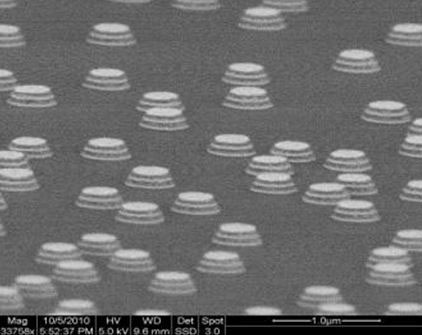| Feb 25, 2013 |
European collaboration sheds light on plasmonic enhancement of solar cell efficiency
|
|
(Nanowerk News) Nanostructured metals can absorb and intensify light at specific wavelengths. This phenomenon, called plasmonics, has many promising applications: it may be exploited to transmit optical signals through nanosized interconnects on chips, in nanoparticles that recognize and interact with biomolecules, or in solar cells, to increase the light absorption in the cell’s photoactive material, paving the way toward thinner and therefore less expensive energy generation. During the course of the European FP7 PRIMA project, imec and its project partners Imperial College (London, UK), Chalmers University of Technology (Sweden), Photovoltech (Belgium), Quantasol (UK), AZUR SPACE Solar Power (Germany), and Australian National University (Australia) gained essential knowledge in the use of metal nanoparticles to enhance solar cell efficiency.
|
 |
| Scanning electron micrograph of nanostructured features capable of redirecting light to where it can be more effectively utilized.
|
|
One of the project achievements was the development and demonstration of a method to fabricate organic solar cells with a plasmonic nanostructured silver (Ag) rear electrode using hole-mask colloidal lithography (HCL). This low-cost, bottom up and extremely versatile technique was shown to be compatible with the fragile organic semiconductors located underneath. The introduction of a plasmonic nanostructured Ag rear electrode resulted in an efficiency enhancement of more than twofold in the absorption tail.
|
|
With respect to wafer-based solar cells such as those based upon silicon, our results indicate that to enhance solar cell efficiency, plasmonic structures need to be integrated on the back side of the solar cells, and not on the front side. Ag nanodiscs on the front side dielectric antireflection coating (ARC) of silicon-based solar cells resulted in an improved light absorption but no efficiency increase, due to parasitic absorption in the nanoparticles and destructive interferences.
|
|
A 3D simulation tool was developed, accurately modelling both optical and electrical characteristics of solar cell devices based on inorganic semiconductors incorporating plasmonic nanostructures. The model indicated that gold or silver nanoparticles can enhance solar cell efficiencies at certain wavelengths, while at other wavelengths, the solar cell performance degrades. Aluminum nanostructures, on the other hand, can enhance the efficiency over the entire relevant spectral region of a solar cell due to their intrinsically low light absorption and strong scattering. This has been demonstrated experimentally on GaAs solar cells, but can be generalized to silicon cells too.
|

